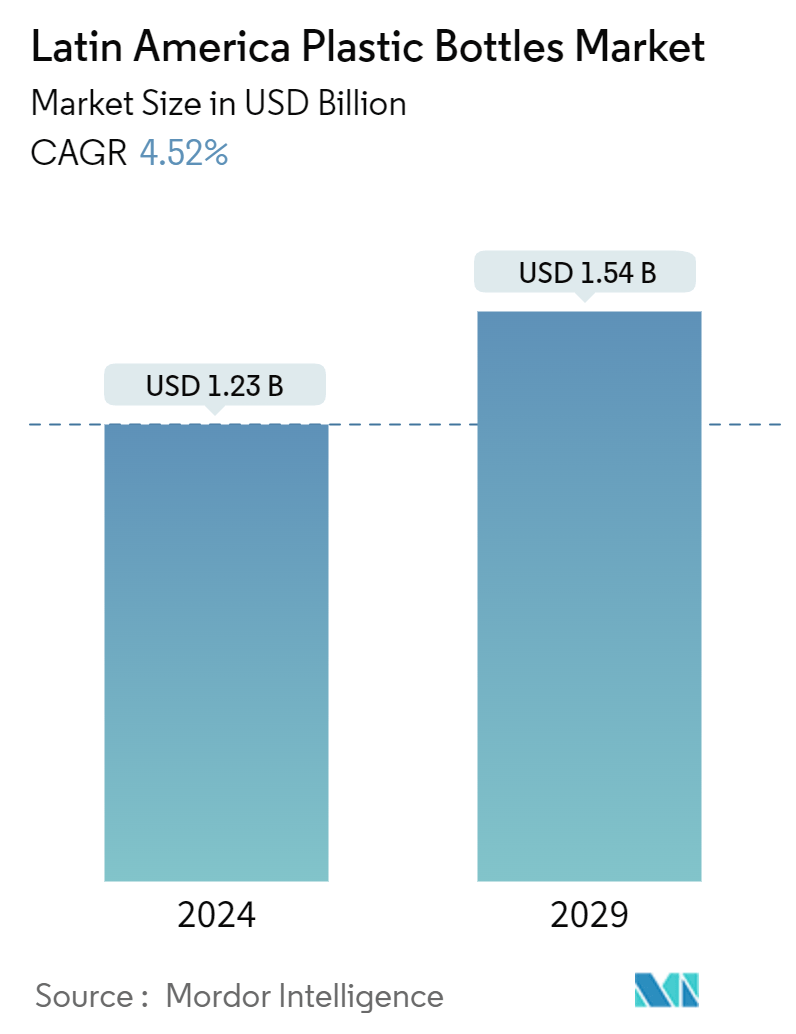Market Size of Latin America Plastic Bottles Industry

| Study Period | 2019 - 2029 |
| Base Year For Estimation | 2023 |
| Market Size (2024) | USD 1.23 Billion |
| Market Size (2029) | USD 1.54 Billion |
| CAGR (2024 - 2029) | 4.52 % |
| Market Concentration | Low |
Major Players.webp)
*Disclaimer: Major Players sorted in no particular order |
Latin America Plastic Bottles Market Analysis
The Latin America Plastic Bottles Market size is estimated at USD 1.23 billion in 2024, and is expected to reach USD 1.54 billion by 2029, growing at a CAGR of 4.52% during the forecast period (2024-2029). In terms of production volume, the market is expected to grow from 130.27 million tonnes in 2024 to 159.79 million tonnes by 2029, at a CAGR of 4.17% during the forecast period (2024-2029).
- Plastic bottles and containers, primarily made of polyethylene terephthalate, polypropylene, and polyethylene, are widely used due to their lightweight and durable nature, which enhances handling efficiency. Manufacturers prefer plastic packaging for its lower production costs. The plastic bottles market in Latin America is expected to grow during the forecast period, driven by the cost-effectiveness of plastic packaging and the increasing consumption of packaged and processed foods and beverages.
- Plastic packaging has become increasingly popular among Latin American consumers due to its lightweight and durable nature, which enhances ease of handling and transportation. Manufacturers favor plastic packaging due to its cost-effective production and versatile design options. The introduction of advanced polymers such as polyethylene terephthalate (PET) and high-density polyethylene (HDPE) has expanded applications for plastic bottles across food and beverage, personal care, and household product industries. The market has seen increased demand for PET bottles, driven by their recyclability, clarity, and barrier properties. This trend is supported by growing consumer awareness of environmental issues and demand for sustainable packaging solutions.
- Plastic bottles and containers are manufactured using various raw plastic materials, with polyethylene terephthalate (PET) being the primary choice due to its durability, versatility, and cost-effectiveness. As end-user industries such as food, beverage, and pharmaceuticals expand and innovate, the demand for plastic bottles and container packaging increases. This growth is driven by changing consumer preferences, urbanization, and the need for convenient packaging solutions. In particular, the food and beverage industry has seen a significant rise in plastic bottles and containers for products ranging from soft drinks and water to sauces and condiments. In the pharmaceutical industry, plastic containers are increasingly used for medication packaging, ensuring product safety and extending shelf life.
- The introduction of new beverages with different flavors and packaging formats in the industry continues to drive the need for rigid plastic bottles. The cosmetics and personal care industry also contributes to the demand, utilizing plastic bottles for products like shampoos, lotions, and creams. As these industries continue to evolve and adapt to consumer needs, the plastic bottle and container market is expected to grow in tandem, offering opportunities for innovation in design, sustainability, and functionality.
- Due to its unique properties, the pharmaceutical industry in Latin America has seen increased demand for plastic packaging. Key features driving adoption include moisture barrier, dimensional stability, impact strength, strain resistance, low water absorption, transparency, heat and flame resistance, and extended product shelf life. These attributes make plastic packaging particularly suitable for protecting and preserving pharmaceutical products.
- The increase in plastic pollution across Latin America has prompted governments to implement policies to reduce plastic waste and promote sustainable packaging solutions. These measures have, to some extent, constrained the market in the region. Plastic has significantly contributed to environmental degradation, and awareness of its effects has grown among users and throughout the industry ecosystem. Governments have conducted numerous public campaigns and initiatives to raise awareness. As concerns about plastic pollution continue to rise, manufacturers and consumers increasingly gravitate toward alternative packaging materials that offer environment-friendly properties and innovative solutions.
- For instance, Valgroup, one of the largest plastic producers, processors, and recyclers in Latin America, acquired the PET bottle recycling operations of 3 Rios Fibras e Resinas in Poços de Caldas, Minas Gerais. The company is investing in expansion, increasing its installed capacity for producing food-grade rPET (recycled PET resin). This recycling process, known as bottle-to-bottle, transforms post-consumer PET bottles into new ones ready for filling. Valgroup's PET recycling plants in Brazil, Mexico, and Spain collectively process 145,000 tons of post-consumption recycled resin annually.

